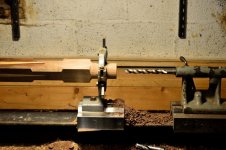I have set aside a few pieces of wood that might be pleasing rifle stocks.
Currently, the AR-15/ LR-308 style rifles are catching my interest.
I would like to drill those "Lo-o-o-ng" holes for the A2 stock and receiver extension.
I could see the work going well on a metal working lathe with the stock blank mounted on the carriage.
I'm reluctant to run that much wood on any of my machines, but I suppose a well designed vacuum system would cover the concerns.
My thinking is that the "stock" would be shaped around the drilling. not the opposite.
Suggestions? Suitable tooling? I'm assuming a bell hangers auger is NOT the correct choice, but I could be wrong. ;-)
Currently, the AR-15/ LR-308 style rifles are catching my interest.
I would like to drill those "Lo-o-o-ng" holes for the A2 stock and receiver extension.
I could see the work going well on a metal working lathe with the stock blank mounted on the carriage.
I'm reluctant to run that much wood on any of my machines, but I suppose a well designed vacuum system would cover the concerns.
My thinking is that the "stock" would be shaped around the drilling. not the opposite.
Suggestions? Suitable tooling? I'm assuming a bell hangers auger is NOT the correct choice, but I could be wrong. ;-)





 But you may find that if you drill the hole to size, and if it is a close fit, after you carve the stock, the hole may have warped. Or maybe not.
But you may find that if you drill the hole to size, and if it is a close fit, after you carve the stock, the hole may have warped. Or maybe not.